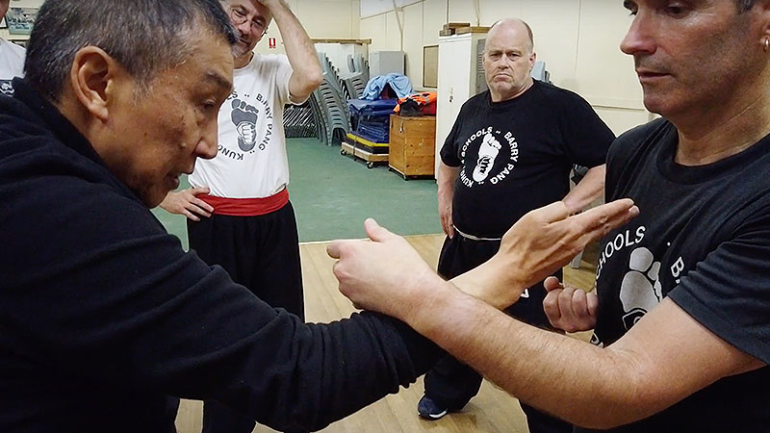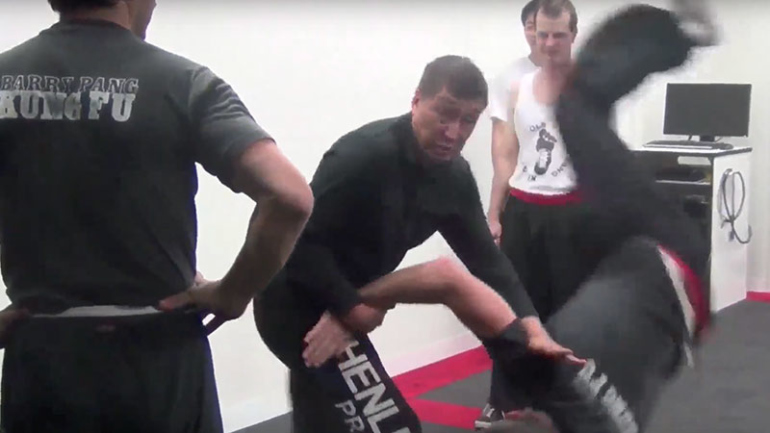In an ideal world, Wing Chun’s “I’ll hit him first” plan works every time. However, living in the real world, tools to counter the clinch are critical to rounding out your martial arts.
UFC and Jiu Jitsu have popularised a certain type of fighting method. Both seek to destabilise and bring down an opponent. Similarly, in self-defence situations encounters often devolve into aggressive grabbing and takedowns. Thinking that a strike-first option is viable 100% of the time is optimistic at best. Maybe you can land something first and maybe it stops him. But what if it doesn’t?
Stopping someone with one punch every single time is not feasible
Barry Pang
Sifu Barry Pang explains how his school’s combination of Wing Chun and Lung Ying kung fu approaches the in-close clinch. His training partners in the video include a former Australasian Open Styles Kung Fu champion.
Watch the video:
Related styles deliver advantages
By focussing on goals rather than a single specific style, the advantages flow. The Barry Pang Kung Fu lineage comes from two masters that developed their art with this in mind:
Wong Shun Leung (1935-1997) was an experienced boxer before joining Grandmaster Ip Man to become Wing Chun’s most accomplished fighter in challenge matches.
Grandmaster Wu Hua Tai (1914-2002) developed his kung fu over many decades, drawing on a range of complementary styles with Lung Ying (Dragon Shape) as his core style.
Extending Wing Chun
Barry Pang Kung Fu incorporated Grandmaster Wu’s Lung Ying in the 1990s, building on top of a well established Wing Chun foundation. The primary benefits are as follows.
Sensitivity & reflex beyond the arms — Build on Wing Chun’s Chi Sao with two additional partner training exercises that utilise dynamic hip power and sensitivity training beyond the forearms. Tai Chi’s Tui Sao (single and double-hand variations) trains dynamic use of the lower body and an improved ability to yield and let force go. Liu He Ba Fa’s Yiu Shun partner work also mobilises the legs whilst training the ability to yield at three contact points: Wrists, elbows and shoulders.
Stability & power through the hips — Enhance the ability to unbalance opponents with lower section strength that goes beyond Wing Chun’s ‘cat stance’ capability. For developing strength there are solo exercises like Lung Ying’s Na Ma stepping and Liu He Ba Fa’s Yiu Shun. Learning how to apply power can be done through partner training, such as Lung Ying’s Chuk Sarm Dim, Liu He Ba Fa’s Yiu Shun and Tai Chi’s Tui Sao.
Striking at extreme close range — Extend Wing Chun’s close-range strikes with even closer-range Lung Ying forearm strikes. Boi Gim is a forearm strike that can be thrown when too close for a centreline punch. Similar to a Wing Chun Pak Sao, the Cup Sao serves to clear the path for a strike, except that it brings the opponent’s guard down.
The summary is that you can extend Wing Chun skillsets with complimentary tools. You can improve the odds of surviving a fast-moving clinch and takedown. You can extend your kung fu to become more holistic by including tools that naturally fit together.




